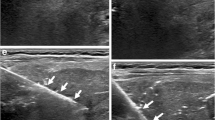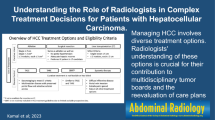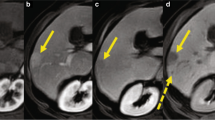Abstract
Imaging is crucial in the assessment of children with a primary hepatic malignancy. Since its inception in 1992, the PRETEXT (PRE-Treatment EXTent of tumor) system has become the primary method of risk stratification for hepatoblastoma and pediatric hepatocellular carcinoma in numerous cooperative group trials across the world. The PRETEXT system is made of two components: the PRETEXT group and the annotation factors. The PRETEXT group describes the extent of tumor within the liver while the annotation factors help to describe associated features such as vascular involvement (either portal vein or hepatic vein/inferior vena cava), extrahepatic disease, multifocality, tumor rupture and metastatic disease (to both the lungs and lymph nodes). This manuscript is written by members of the Children’s Oncology Group (COG) in North America, the International Childhood Liver Tumors Strategy Group (SIOPEL) in Europe, and the Japanese Study Group for Pediatric Liver Tumor (JPLT; now part of the Japan Children’s Cancer Group) and represents an international consensus update to the 2005 PRETEXT definitions. These definitions will be used in the forthcoming Trial to Pediatric Hepatic International Tumor Trial (PHITT).




















Similar content being viewed by others
References
Mackinlay GA, Pritchard (1992) A common language for childhood liver-tumors. Pediatr Surg Int 7:325–326
Aronson DC, Schnater JM, Staalman CR et al (2005) Predictive value of the pretreatment extent of disease system in hepatoblastoma: results from the International Society of Pediatric Oncology Liver Tumor Study Group SIOPEL-1 study. J Clin Oncol 23:1245–1252
Brown J, Perilongo G, Shafford E et al (2000) Pretreatment prognostic factors for children with hepatoblastoma — results from the International Society of Paediatric Oncology (SIOP) study SIOPEL 1. Eur J Cancer 36:1418–1425
Pritchard J, Brown J, Shafford E et al (2000) Cisplatin, doxorubicin, and delayed surgery for childhood hepatoblastoma: a successful approach — results of the first prospective study of the International Society of Pediatric Oncology. J Clin Oncol 18:3819–3828
Perilongo G, Shafford E, Maibach R et al (2004) Risk-adapted treatment for childhood hepatoblastoma. Final report of the second study of the International Society of Paediatric Oncology — SIOPEL 2. Eur J Cancer 40:411–421
Hishiki T, Matsunaga T, Sasaki F et al (2011) Outcome of hepatoblastomas treated using the Japanese Study Group for Pediatric Liver Tumor (JPLT) protocol-2: report from the JPLT. Pediatr Surg Int 27:1–8
Roebuck DJ, Aronson D, Clapuyt P et al (2007) 2005 PRETEXT: a revised staging system for primary malignant liver tumours of childhood developed by the SIOPEL group. Pediatr Radiol 37:123–132
Meyers RL, Tiao G, de Ville de Goyet J et al (2014) Hepatoblastoma state of the art: pre-treatment extent of disease, surgical resection guidelines and the role of liver transplantation. Curr Opin Pediatr 26:29–36
Czauderna P, Haeberle B, Hiyama E et al (2016) The Children's Hepatic tumors International Collaboration (CHIC): novel global rare tumor database yields new prognostic factors in hepatoblastoma and becomes a research model. Eur J Cancer 52:92–101
Meyers RL, Maibach R, Hiyama E et al (2017) Risk-stratified staging in paediatric hepatoblastoma: a unified analysis from the Children's Hepatic tumors International Collaboration. Lancet Oncol 18:122–131
Haberle B, Bode U, von Schweinitz D (2003) Differentiated treatment protocols for high- and standard-risk hepatoblastoma — an interim report of the German Liver Tumor Study HB99. Klin Padiatr 215:159–165
Katzenstein HM, Chang KW, Krailo M et al (2009) Amifostine does not prevent platinum-induced hearing loss associated with the treatment of children with hepatoblastoma: a report of the Intergroup Hepatoblastoma Study P9645 as a part of the Children's Oncology Group. Cancer 115:5828–5835
Malogolowkin MH, Katzenstein H, Krailo MD et al (2006) Intensified platinum therapy is an ineffective strategy for improving outcome in pediatric patients with advanced hepatoblastoma. J Clin Oncol 24:2879–2884
Ortega JA, Douglass EC, Feusner JH et al (2000) Randomized comparison of cisplatin/vincristine/fluorouracil and cisplatin/continuous infusion doxorubicin for treatment of pediatric hepatoblastoma: a report from the Children's Cancer Group and the Pediatric Oncology Group. J Clin Oncol 18:2665–2675
Perilongo G, Maibach R, Shafford E et al (2009) Cisplatin versus cisplatin plus doxorubicin for standard-risk hepatoblastoma. New Engl J Med 361:1662–1670
Sasaki F, Matsunaga T, Iwafuchi M et al (2002) Outcome of hepatoblastoma treated with the JPLT-1 (Japanese Study Group for Pediatric Liver Tumor) protocol-1: a report from the Japanese Study Group for Pediatric Liver Tumor. J Pediatr Surg 37:851–856
von Schweinitz D, Hecker H, Harms D et al (1995) Complete resection before development of drug resistance is essential for survival from advanced hepatoblastoma — a report from the German Cooperative Pediatric Liver Tumor Study HB-89. J Pediatr Surg 30:845–852
Kolbe AB, Podberesky DJ, Zhang B, Towbin AJ (2015) The impact of hepatocyte phase imaging from infancy to young adulthood in patients with a known or suspected liver lesion. Pediatr Radiol 45:354–365
Meyers AB, Towbin AJ, Geller JI, Podberesky DJ (2012) Hepatoblastoma imaging with gadoxetate disodium-enhanced MRI — typical, atypical, pre- and post-treatment evaluation. Pediatr Radiol 42:859–866
Meyers AB, Towbin AJ, Serai S et al (2011) Characterization of pediatric liver lesions with gadoxetate disodium. Pediatr Radiol 41:1183–1197
Pugmire BS, Towbin AJ (2016) Magnetic resonance imaging of primary pediatric liver tumors. Pediatr Radiol 46:764–777
Saettini F, Conter V, Provenzi M et al (2014) Is multifocality a prognostic factor in childhood hepatoblastoma? Pediatr Blood Cancer 61:1593–1597
McCarville MB, Kao SC (2006) Imaging recommendations for malignant liver neoplasms in children. Pediatr Blood Cancer 46:2–7
McCarville MB, Roebuck DJ (2012) Diagnosis and staging of hepatoblastoma: imaging aspects. Pediatr Blood Cancer 59:793–799
Roebuck DJ (2009) Assessment of malignant liver tumors in children. Cancer Imaging 9A:S98–s103
McEvoy SH, McCarthy CJ, Lavelle LP et al (2013) Hepatocellular carcinoma: illustrated guide to systematic radiologic diagnosis and staging according to guidelines of the American Association for the Study of Liver Diseases. Radiographics 33:1653–1668
Wald C, Russo MW, Heimbach JK et al (2013) New OPTN/UNOS policy for liver transplant allocation: standardization of liver imaging, diagnosis, classification, and reporting of hepatocellular carcinoma. Radiology 266:376–382
Darcy DG, Malek MM, Kobos R et al (2015) Prognostic factors in fibrolamellar hepatocellular carcinoma in young people. J Pediatr Surg 50:153–156
Qiao G, Cucchetti A, Li J et al (2016) Applying of pretreatment extent of disease system in patients with hepatocellular carcinoma after curative partial hepatectomy. Oncotarget 7:30408–30419
Weeda VB, Murawski M, McCabe AJ et al (2013) Fibrolamellar variant of hepatocellular carcinoma does not have a better survival than conventional hepatocellular carcinoma — results and treatment recommendations from the Childhood Liver Tumour Strategy Group (SIOPEL) experience. Eur J Cancer 49:2698–2704
Meyers RL, Rowland JR, Krailo M et al (2009) Predictive power of pretreatment prognostic factors in children with hepatoblastoma: a report from the Children's Oncology Group. Pediatr Blood Cancer 53:1016–1022
Bismuth H (2013) Revisiting liver anatomy and terminology of hepatectomies. Ann Surg 257:383–386
Lafortune M, Madore F, Patriquin H, Breton G (1991) Segmental anatomy of the liver: a sonographic approach to the Couinaud nomenclature. Radiology 181:443–448
Majno P, Mentha G, Toso C et al (2014) Anatomy of the liver: an outline with three levels of complexity — a further step towards tailored territorial liver resections. J Hepatol 60:654–662
Iqbal S, Iqbal R, Iqbal F (2017) Surgical implications of portal vein variations and liver segmentations: a recent update. J Clin Diagn Res 11:AE01–AE05
Roebuck DJ, Sebire NJ, Pariente D (2007) Assessment of extrahepatic abdominal extension in primary malignant liver tumours of childhood. Pediatr Radiol 37:1096–1100
Maibach R, Roebuck D, Brugieres L et al (2012) Prognostic stratification for children with hepatoblastoma: the SIOPEL experience. Eur J Cancer 48:1543–1549
Dall'Igna P, Cecchetto G, Toffolutti T et al (2003) Multifocal hepatoblastoma: is there a place for partial hepatectomy? Med Pediatr Oncol 40:113–116
Meyers RL, Czauderna P, Otte JB (2012) Surgical treatment of hepatoblastoma. Pediatr Blood Cancer 59:800–808
Zsiros J, Brugieres L, Brock P et al (2013) Dose-dense cisplatin-based chemotherapy and surgery for children with high-risk hepatoblastoma (SIOPEL-4): a prospective, single-arm, feasibility study. Lancet Oncol 14:834–842
Doyon F, Attenberger UI, Dinter DJ et al (2015) Clinical relevance of morphologic MRI criteria for the assessment of lymph nodes in patients with rectal cancer. Int J Color Dis 30:1541–1546
Wray R, Sheikhbahaei S, Marcus C et al (2016) Therapy response assessment and patient outcomes in head and neck squamous cell carcinoma: FDG PET Hopkins criteria versus residual neck node size and morphologic features. AJR Am J Roentgenol 207:641–647
O’Neill AF, Towbin AJ, Krailo MD, et al (2017) Characterization of Pulmonary Metastases in Children With Hepatoblastoma Treated on Children’s Oncology Group Protocol AHEP0731 (The Treatment of Children With All Stages of Hepatoblastoma): A Report From the Children’s Oncology Group. J Clin Oncol 35:3465–3473.
Yadav SS, Lawande MA, Patkar DA, Pungavkar SP (2012) Rare case of hemorrhagic brain metastasis from hepatoblastoma. J Pediatr Neurosci 7:73–74
Towbin AJ, Braojos Braga FDC, Zhang B et al (2017) Fractures in newly diagnosed hepatoblastoma patients. Pediatr Radiol. https://doi.org/10.1007/s00247-017-4050-3
Roebuck DJ, Olsen O, Pariente D (2006) Radiological staging in children with hepatoblastoma. Pediatr Radiol 36:176–182
Archer D, Babyn P, Gilday D, Greenberg MA (1993) Potentially misleading bone scan findings in patients with hepatoblastoma. Clin Nucl Med 18:1026–1031
Author information
Authors and Affiliations
Corresponding author
Additional information
CME activity This article has been selected as the CME activity for the current month. Please visit the SPR website at www.pedrad.org on the Education page and follow the instructions to complete this CME activity.
Rights and permissions
About this article
Cite this article
Towbin, A.J., Meyers, R.L., Woodley, H. et al. 2017 PRETEXT: radiologic staging system for primary hepatic malignancies of childhood revised for the Paediatric Hepatic International Tumour Trial (PHITT). Pediatr Radiol 48, 536–554 (2018). https://doi.org/10.1007/s00247-018-4078-z
Received:
Revised:
Accepted:
Published:
Issue Date:
DOI: https://doi.org/10.1007/s00247-018-4078-z




